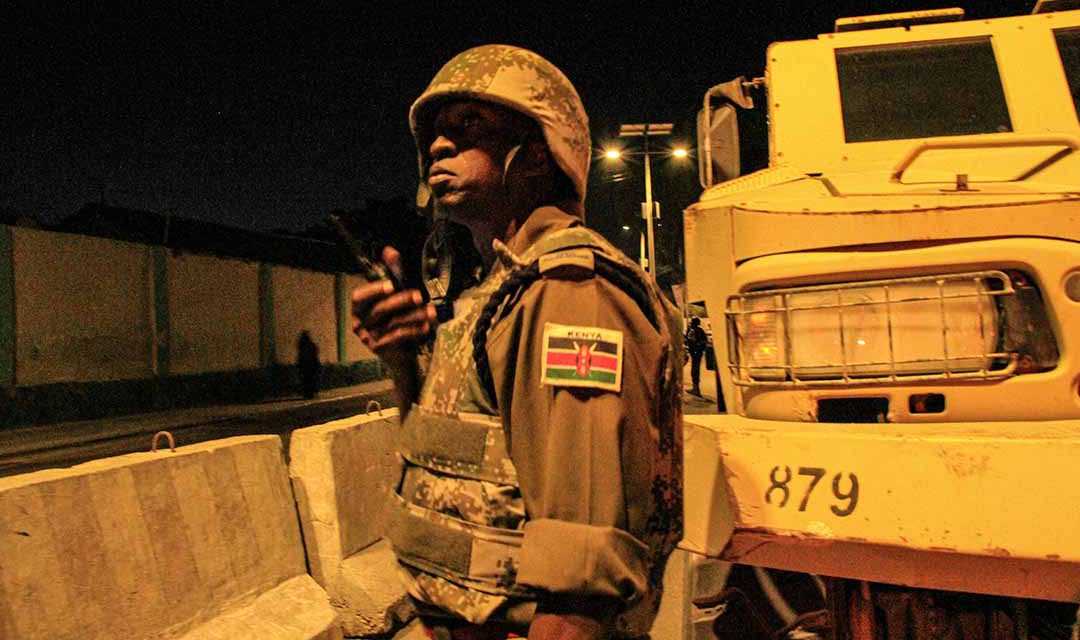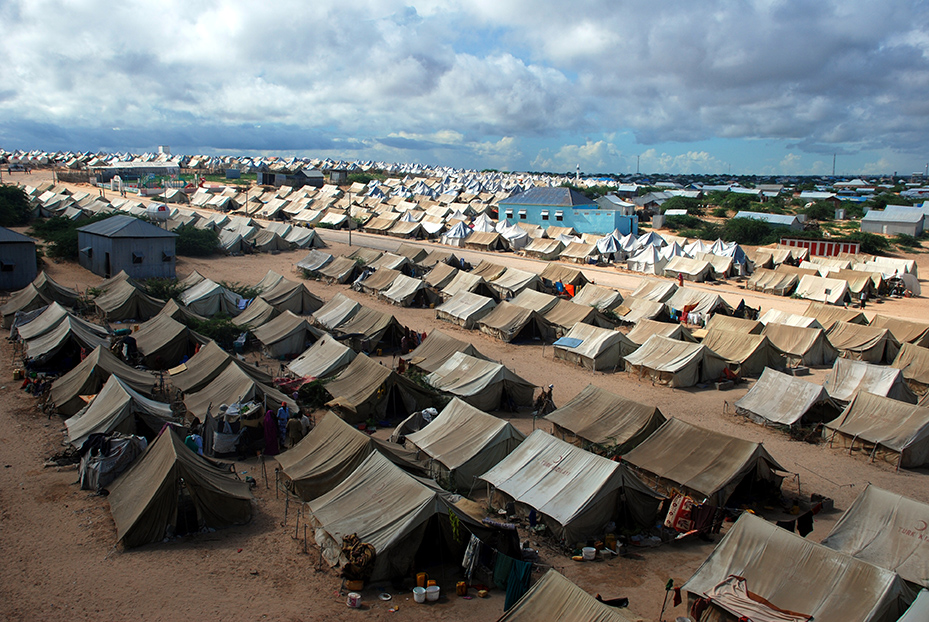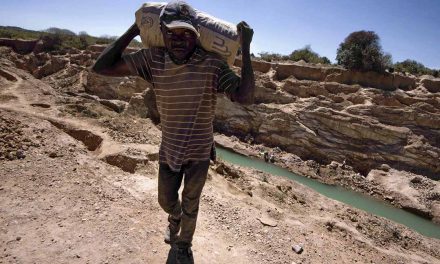Africa: fragile gains
There’s been some progress towards ending wars on the continent, but 2020 was never a realistic goal for ending all conflicts

A Kenyan police officer of the African Union’s peacekeeping mission in Somalia (AMISOM) takes part in a night patrol on a street in Mogadishu in September 2019. Photo: TINA SMOLE / AFP
Seven years ago, in 2013, African leaders solemnly vowed “not to bequeath the burden of conflicts to the next generation of Africans”. The occasion was the 50th anniversary of the founding of the continent’s premier political body, the Organisation of African Unity, the predecessor of today’s African Union (AU). As part of a broader development plan extending to the hundredth anniversary, the AU set a goal of ending all African wars by 2020. That campaign, known as Silencing the Guns, is now reaching its deadline. It has registered some accomplishments in that short time. During 2019 alone, the AU helped negotiate new peace accords among warring parties in South Sudan and the Central African Republic (CAR).
Then in August, AU and Ethiopian mediators persuaded Sudan’s generals to form a transitional government with leaders of the popular uprising that had ousted longtime dictator Omar al-Bashir four months earlier, at least momentarily averting the likelihood of greater bloodshed. The gains remain fragile, however. And across the continent, Africans continue to die in large numbers. According to Uppsala University’s Conflict Data Programme, some 15,000 people were killed in violent confrontations in Africa in 2018, the last year for which figures are available. The bulk of those casualties were in five countries: with Nigeria at the top, followed by Somalia, the Democratic Republic of Congo (DRC), the CAR and Mali. Although 2018’s total was notably down from a peak of more than 24,000 deaths in 2014, it was still only slightly below the figure for the year Silencing the Guns began.
“As human beings we cannot accept such levels of violence,” AU commissioner for peace and security Smail Chergui told a reporter for the London magazine New African in February 2019. However, sceptics, accustomed to the organisation’s history of unmet targets, never expected very much. The limited results have less to do with excessive ambition than with the sheer difficulty of quickly resolving such complex conflicts. The tight deadline was intended to spur African leaders to concentrate their energies more than they might have otherwise. Everyone agrees that ending war is essential for Africa’s future. “We cannot have sustainable development without sustaining peace,” Amina Mohammed, the UN deputy secretary-general, who is from Nigeria, observed at a March 2019 African regional conference in Morocco.
She promptly added: “neither can we build a secure future for everyone without addressing the root causes of our conflicts and vulnerabilities.” The old Organisation of African Unity (OAU) only occasionally engaged in peacekeeping, hindered by its prohibition against African interference in the internal affairs of member states. By the early 1990s, as more conflicts erupted, that notion began to change. The principle of noninterference became less categorical in the face of massive human rights violations and population displacements that threatened regional security. The OAU set up new mechanisms to quickly field mediation and observer missions. Initially, however, the most active African-led peacekeeping came from regional organisations such as the Economic Community of West African States (ECOWAS) or East Africa’s Intergovernmental Authority on Development, sometimes as precursors to better-financed UN operations.
With the transformation of the OAU into the AU in 2002, security issues acquired an even higher priority. The AU’s Constitutive Act explicitly gave it authority to “intervene in cases of war crimes, genocide and crimes against humanity”, thereby replacing the principle of non-interference with one of “non-indifference”. Still, it took some time before African leaders assumed greater responsibility to act on their own, rather than leaving the task to the UN or other foreign entities. The AU has mounted peacekeeping missions in Darfur, Burundi, Somalia and several other countries. It is also in the process of establishing an African standby force capable of rapid interventions. The Silencing the Guns campaign builds on those efforts. It explicitly links security with the wider range of AU concerns.
Eliminating the root causes of conflict in African societies, notes the 2013 declaration, will require effort on a number of levels: improved governance, better entrenched democratic and human rights norms and stronger anti-corruption measures. Economic and social disparities fuel tensions and discontent, especially among marginalised ethnic groups, youth and women, and they need to be addressed. Making progress in all these areas, moreover, cannot rest on the shoulders of African leaders alone. A detailed “Master Roadmap” to ending conflicts adopted in 2017 specifies tasks to be carried out by the AU, regional organisations, governments, international partners, civil society groups, and local communities. Like the UN and other organisations, the AU emphasises the need to increase women’s involvement in peace efforts, often citing the role of women activists in helping end Liberia’s civil war.
But the record so far is disappointing, for the AU as well as its partners. In Mali, for example, the highest body overseeing the implementation of a 2015 peace agreement is composed entirely of men. Women did better in Sudan. After the AU suspended Sudan’s membership in June 2019 to pressure the junta into negotiating seriously with protest leaders, women had limited involvement in the talks. But when the resulting transitional government was announced, four women figured among the 18 cabinet members, including the new foreign minister, Asmaa Mohammed Abdullah. Levinia Addae-Mensah, deputy executive director of the West Africa Network for Peacebuilding, says that there has been only a “marginal increase” in women’s roles in African peace efforts. And while a few women may now be in prominent positions, their absence on the ground is most serious.
Pointing to the need to narrow the gap between national decision makers and local communities, she told allAfrica.com, “that is why we want the voices of women to be heard in … community dialogues”. The AU originally sent peacekeepers to Darfur, Sudan in 2004 at a time of widespread killings by pro-government militias. In 2007, when the UN authorised its own intervention, the AU troops were merged into the UN-AU Mission in Darfur, the first such hybrid undertaking. There is still no peace agreement between Khartoum and the Darfur rebels, but the violence has declined considerably. Also in 2007, the AU established a Somalia peacekeeping mission to support the government in Mogadishu. Despite the presence of nearly 20,000 AU troops there, parts of the country remain outside government control and insurgents continue to attack Somali and AU positions, including in the capital.
The AU’s peace toolkit is varied, however, and includes a spectrum of initiatives, from conflict prevention to post-conflict stabilisation. Mediation, which requires no troops, arms or expensive logistical support, is an important one. In March 2019, a peace accord between various rebel groups and the government of the CAR was on the verge of collapsing, as its seven predecessors had. The AU hastily brokered a new round of talks that brought more rebel leaders into the deal. According to Mankeur Ndiaye, head of the UN’s CAR peacekeeping mission, the competing rebel factions still sometimes fight each other, but “there are no more direct confrontations between the government and the armed groups”. In 2019, the AU sent election monitoring missions to Madagascar and the DRC, with the aim of averting renewed partisan bloodshed.
While the election in the DRC featured major irregularities, both contests yielded political reconciliation rather than violence. The AU is also working to control the proliferation of illicit guns. An AU funded report by the Small Arms Survey, a Geneva research group, estimates there were more than 50 million small arms and light weapons in Africa in 2017. Only one fifth were held by official military or police forces. The rest were in the hands of non-state armed groups, private security businesses and individuals. Such weapons have fuelled fighting by organised factions, but they have also aggravated community disputes and enabled all sorts of criminal activity. Small arms, notes Kwesi Aning, a director of the Kofi Annan International Peacekeeping Training Centre in Ghana, are “Africa’s weapons of mass destruction”. Reducing illegal imports or cross-border smuggling is difficult.
Small arms experts argue that the demand for guns must be reduced, whether through the disarmament of organised military factions or by better ensuring the safety of local communities, which often acquire arms for self-defence against marauding rebels, predatory soldiers or bandits. Consolidating peace after conflicts formally end is essential for preventing a reversion to warfare. But funding is often scarce for community recovery efforts, the reintegration of ex-combatants and numerous other pressing tasks. One of the greatest handicaps, notes the AU’s Master Roadmap, is “inadequate resources” for financing peace operations. The AU has struggled to ensure funding from its own members. Until recently, only about two thirds of assessed contributions were collected, with more than half of all members in default.
In 2017, the AU started assessing a 0.2% levy on all imports into African countries to support the group’s various activities. It is also exploring other, more innovative ways to raise funds. Regional African organisations face similar problems. Despite meagre resources, the Sahel Group of Five (Burkina Faso, Chad, Mali, Mauritania and Niger) launched a joint anti-terrorist military force, but after several years have yet to mount significant ground operations against jihadist groups active there. But a September 2019 summit meeting of the broader ECOWAS decided to commit $1 billion over four years to combating jihadism in the Sahel, in principle tapping the greater resources of Nigeria and other states in the region. More international support will also be essential, including from the UN, which currently has seven peacekeeping missions in Africa.
The UN, however, faces resource difficulties of its own, especially with major US cutbacks to its funding contributions. In July 2019 the AU Executive Council proclaimed that its theme for 2020 would be “Silencing the Guns: Creating Conducive Conditions for Africa’s Development”, inviting African leaders to take stock of what has been achieved so far. But by tacitly dropping the 2020 deadline, the body suggested that the process will be ongoing. Whatever new mechanisms or timetables Africans develop, reducing mass bloodshed will remain a vital goal for the continent’s future.










